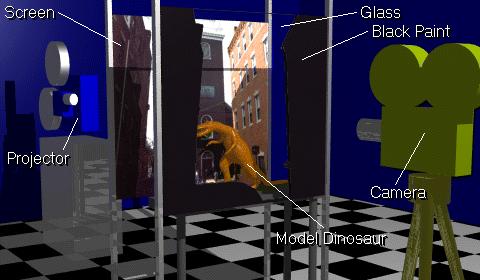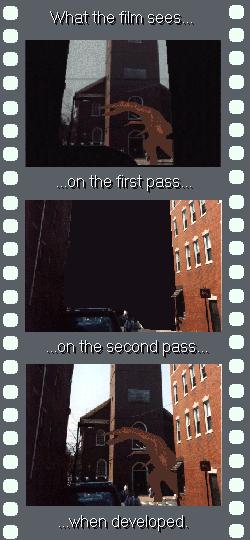pop up description layer
HOME
Cryptozoology UFO Mysteries Aviation Space & Time Dinosaurs Geology Archaeology Exploration 7 Wonders Surprising Science Troubled History Library Laboratory Attic Theater Store Index/Site Map Cyclorama
Search the Site: |
|
Harryhausen's Dynamation
Ray Harryhausen was one of the great stop-motion artists of the 20th century. Harryhausen, along with Willis O'Brien, Jim Danforth and David Allen, were responsible for giving the public fantasy films like King Kong, Mighty Joe Young, The Golden Voyage of Sinbad, Jason and the Argonauts and many others. The incredible creatures shown in these pictures ranged from dinosaurs to skeleton swordsmen. The creatures in these movies were given life through a technique called stop-motion animation. Typically, a miniature model of the creature constructed with posable limbs and body and was placed in a miniature set and photographed by a motion picture camera one frame at a time. Changing the pose between frames would cause the model to appear to be moving by itself in the final film. Despite success in early movies such as King Kong, the technique had its weaknesses. The miniature sets were expensive to construct and it was very difficult to combine live action in the same frame as the stop-motion creatures. While working on a low-budget film called The Beast from 20,000 Fathoms, Harryhausen came up with a technique he later named "dynamation" that eased both of these problems. The technique used a split screen, with rear projection. Split screen had been around as a special effect from almost the beginning of film itself. One early clip from France shows a bicycle rider sailing over the city of Paris. The photographer had shot it by covering the bottom half of the lens of the camera with black tape, then filming the bicycle rider through the top half. The mask was then reversed and the film rewound inside the camera. The film was exposed again, this time photographing the city of Paris through the bottom half of the lens. When the film was developed, the rider appeared to be sailing across the Paris skyline. Harryhausen's dynamation used the same basic idea with some additional twists.
The camera would be set on a real street and the actors would be filmed running towards the camera. The camera is locked so it does not change position at all while filming the background. The background film is then developed and loaded into a projector back at the studio. The projector then projects the first frame onto a back projection screen. The back projection screen is a thin piece of plastic stretched tightly across a frame. Unlike a regular screen, the image appears on the front when illuminated by a projector from behind. A motion picture camera is loaded with film and locked into position in front of the screen so it can rephotograph the film clip as it is projected onto the screen. This camera will be used to capture the new action. A piece of glass is then put between the camera and the screen. The glass is painted with black paint so that portions of the image on the screen that are to be in front of the dinosaur (the foreground) are blacked out when seen by the camera. In our example this would be the bottom of the screen and the building from behind which the dinosaur emerges. In between the glass and the screen a table is set up on which the miniature dinosaur is placed. The table might also hold anything that the dinosaur might directly interact with during the scene (let's say a lamp post that he can gnaw on). The dinosaur is carefully positioned so that it is matched for size and position with the image on the screen as seen through the camera. The film in the projector is advanced one frame at a time. With each frame the dinosaur is moved to simulate walking out from behind the building. After the position of the dinosaur is correct, the camera captures one frame. The frame at this point shows the background image of the upper half of the screen, the model dinosaur in front of it, and the blacked out portions of the glass. After the entire scene has been filmed both the projector and the camera are rewound back to the beginning. The glass is removed and another sheet of glass is inserted. The new glass is the reverse of the first one, though, as the portions of the glass that were clear now have been painted over and the sections that were blacked out are now clear. The model dinosaur and the table are cleared away. The film is re-shot again, this time exposing the foreground part of the image which had before been blacked out. When the film from the camera is developed and viewed it will show the dinosaur apparently moving out from behind the building. The use of dynamation allowed Harryhausen to dispense with many expensive miniature sets (In our above example only the dinosaur and a streetlight need to be constructed in miniature). It was also used in later films to allow very close interaction between the human actors and the animated creatures. Because the model was animated directly in front of the screen that was showing the human actors, it was possible for Harryhausen to synchronize the movements of the models with the previously-filmed action. This allowed sword fights between humans and skeletons where each could parry and thrust convincingly. As effective as dynamation was, it had flaws. It was often extremely difficult to match parts of the miniature set with the previously filmed-material for brightness and color. Also, none of the human characters could pass in front of the miniature objects, only behind them. (A separate technique, back projection, that could be used in other shots did put the human action in front, however). Despite the problems in the process, Harryhausen's dynamation gave audiences thrills for decades until sophisticated computer graphics became available. Here is a list of Harryhausen films using the dynamation process, though not all were billed with the dynamation label: The Beast from 20,000 Fathoms (1953) It came from Beneath the Sea (1954) Earth vs. the Flying Saucers (1956) The Animal World (1956) 20 Million Miles to Earth (1957) The 7th Voyage of Sinbad (1958) The 3 Worlds of Gulliver (1959) Mysterious Island (1961) Jason and the Argonauts (1963) First Men in the Moon (1964) One Million Years B.C. (1967) The Valley of Gwangi (1969) The Golden Voyage of Sinbad (1974) Sinbad and the Eye of the Tiger (1977) Clash of the Titans (1981) Copyright Lee Krystek 1999. All Rights Reserved. |
|
Related Links |
|
|




 The
first step in dynamation was to film the background image. For
this example let's say the scene is to show a dinosaur in a
big city emerging from behind a building into an intersection.
People are running away from the creature down the street toward
the camera (A similar scene is in The Beast from 20,000 Fathoms).
The
first step in dynamation was to film the background image. For
this example let's say the scene is to show a dinosaur in a
big city emerging from behind a building into an intersection.
People are running away from the creature down the street toward
the camera (A similar scene is in The Beast from 20,000 Fathoms).
